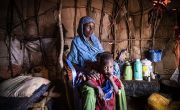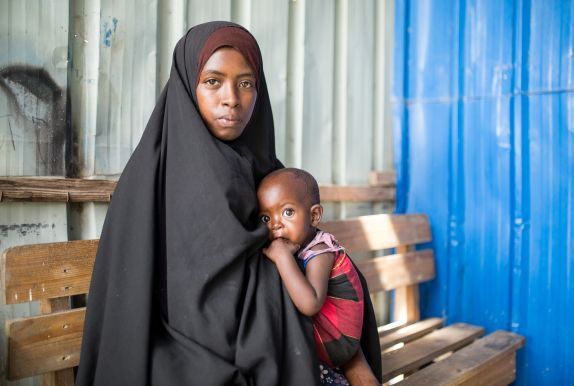
Knowledge Hub
Over 250,000 people were killed by drought-induced famine in Somalia in 2011 — at least half of them were children. Experts are now saying that the current situation in East Africa is even worse.
East Africa, which includes Somalia, Ethiopia and Kenya, is experiencing its worst drought in four decades, as the region faces a predicted fifth consecutive failed rainy season. Alarm bells have been ringing for months, but with other crises like the conflict in Ukraine ongoing, East Africa has not been the focus of the world’s attention.
However, with famine imminent in parts of Somalia, action is urgently needed from world leaders and the humanitarian community to avert a major crisis.
An avoidable hunger crisis
The drought in East Africa is the result of four consecutive dry seasons, with many places not experiencing rain since 2020. Drought would have a major effect on any country in the world, but the situation is having an even more devastating impact on East Africa as most people there are farmers, and are reliant on their land and livestock to survive. So when drought strikes, there is an immediate impact on their ability to work and feed their families. Lakeside communities in Turkana, Kenya, can no longer survive on fishing; water wells have dried up across Somalia; millions of livestock have died.
The situation has been exacerbated by a number of factors. Firstly, climate change. While this drought isn’t the direct result of climate change — it has been induced by La Niña, or an intensification of normal weather patterns — it has made it worse and prolonged the conditions. This is despite the region being one of the least responsible for climate change, being responsible for just 0.1% of global carbon emissions.

Conflict, the world’s single biggest driver of hunger, also plays an outsized role. Conflict in Somalia has left the region even more vulnerable, as displaced families searching for food and water are left in unstable areas and are more susceptible to violence. Meanwhile, the ongoing conflict in Ukraine has had a huge impact on East Africa. Ukraine and the Russian Federation are among the world’s “breadbaskets”, in that they provide around 30% of the world’s wheat and barley. Somalia, for example, imported 90% of its wheat from these countries, so has been hit with a double whammy of scarcity of wheat and rocketing prices. In addition, conflict makes it more difficult for humanitarian organisations to reach those who need help the most.
The latest figures from OCHA report that a staggering 20 million people are in emergency or catastrophic levels of food insecurity in Kenya, Somalia, and Ethiopia, with 36 million people in total across East Africa facing these levels of food insecurity. And things are only set to get worse, as a fifth failed rainy season is forecasted this October.
Sadly, we could see the warning signs. Back in 2011, severe drought affected 13 million people across the region, with Somalia suffering the most as conflict exacerbated the situation. In July that year, famine was declared in Somalia, with 260,000 people dying — half of them children under five. Many died before the official declaration of famine. A slow response to the crisis was criticised as donors and leaders failed to act on warnings as early as 2010 that famine could break out, with 3.7 million people at the time experiencing crisis levels of food insecurity. In 2017, famine was averted in East Africa thanks to improved responses to 2.9 million people facing crisis to emergency levels of food insecurity, but just five years later, we find ourselves in a horribly similar situation — with thousands of lives at stake.
Famine imminent in Somalia
Millions in Ethiopia, Kenya and South Sudan face food insecurity due to the drought, but the situation is most dire in Somalia. Due to the perfect storm of drought, conflict, climate change, economic issues and the Covid-19 pandemic, famine is now “at the door” of Somalia, and children are already dying from malnutrition.
On 5th September 2022, the United Nations declared that famine was imminent in South Central Somalia, in two areas of the Bay region (Baidoa and Burhakaba districts) between this October and December, with conditions lasting until at least March 2023.
The UN’s Under-Secretary-General for Humanitarian Affairs and Emergency Relief Coordinator Martin Griffiths said at a press conference in Mogadishu: “Famine is at the door and today we are receiving a final warning”, adding: “Unprecedented failure of four consecutive rainy seasons, decades of conflict, mass displacement, severe economic issues are pushing many people to that brink of famine.”
I witnessed the drought that killed so many in the Horn of Africa in 2011, but what I am seeing now is far worse.
For famine to be declared, a region must meet specific thresholds — that at least 20% of the population is affected, with about one out of three children being acutely malnourished and two people dying per day for every 10,000 inhabitants due to outright starvation or to the interaction of malnutrition and disease. Sadly, people are already dying. At least 500 children have died in nutrition centres across Somalia since January, according to OCHA figures, and an estimated 1.5 million children under the age of five face acute malnutrition, including 386,400 who are likely to be severely malnourished.
In addition, an estimated 1 million people have been displaced by drought across the country since January 2021, and 45% of the population of Somalia — an estimated 7.1 million people — are acutely food insecure.
“We need immediate and safe access to all people in need across Somalia and the wider region,” said Concern’s Regional Director for the Horn of Africa, Amina Abdulla.
“I witnessed the drought that killed so many in the Horn of Africa in 2011, but what I am seeing now is far worse.
“Hundreds of thousands of people are moving from their homes in search of water, food and healthcare because all the water sources around them have dried up.
“We are very grateful for all the resources we have received so far to support people affected by this catastrophic drought and the many crises it has caused, but we need more.


Concern's response in the Horn of Africa
Somalia
Concern has been working in Somalia since 1986, and is responding to the unfolding crisis by providing support in the areas of food security and livelihoods, health and nutrition, water, sanitation and hygiene.
In the first week in August, Concern saw a 20% increase in total malnutrition admissions in outpatient programmes — jumping from 1427 to 1730 admissions. We are supporting health centres in providing treatment for cholera, measles and acute watery diarrhoea (AWD).
In addition, we are supporting 14 IDP (internally displaced persons) sites through WASH (water, sanitation and hygiene) activities, providing water trucks for 10 sites to assist over 12,000 people, and constructing 105 latrines. Concern’s teams are also rehabilitating boreholes and wells, and distributing hygiene kits.
Kenya
Ethiopia
How you can help
Concern has launched an emergency appeal for East Africa to provide the urgent help needed by millions across Somalia, Ethiopia and Kenya.
We already have established programmes and teams across the region. Your money will enable Concern to meet the immediate needs of communities impacted by the drought, helping those most in need.
Other ways to help
Donate now
Give a one-off, or a monthly, donation today.
Join an event
From mountain trekking to marathon running, join us for one of our many exciting outdoor events!
Buy a gift
With an extensive range of alternative gifts, we have something to suit everybody.
Leave a gift in your will
Leave the world a better place with a life-changing legacy.
Become a corporate supporter
We partner with a range of organisations that share our passion and the results have been fantastic.
Create your own fundraising event
Raise money for Concern by organising your own charity fundraising event.






